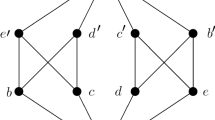Abstract
In this paper, we have established the notions of soft order relations and studied its basic structural properties. We give the concepts of soft maximum, soft minimum, soft maximal, soft minimal, soft infimum and soft supremum in any s-poset. Then, the concept of soft order preserving mapping is defined and given some basic results. Moreover, it has been shown that the topology derived from a soft partial order relation is a soft topology which will substitute as a soft version of Alexandroff topology in classical theory. With all that, we obtained the category \(\textbf{SPOSET}\) of s-posets, and constructed a functor which is called ostracizer functor between the categories \(\textbf{SPOSET}\) and \(\textbf{POSET}\).



Similar content being viewed by others
Data availability
Enquiries about data availability should be directed to the authors.
References
Adamek J, Herrlich H, Strecker GE (1990) Abstract and concrete categories—the joy of cats. Wiley, New York
Aktaş H, Çağman N (2007) Soft sets and soft groups. Inf Sci 177:2726–2735
Alexandroff P (1937) Diskrete raume. Mat Sb (N.S.) 2:501–518
Ali MI, Feng F, Liu XY, Min WK, Shabir M (2009) On some new operations in soft set theory. Comput Math Appl 57:1547–1553
Aygünoğlu A, Aygün H (2012) Some notes on soft topological spaces. Neural Comput Appl 21:113–119
Babitha KV, Sunil JJ (2010) Soft set relations and functions. Comput Math Appl 60:1840–1849
Billingsley P (1979) Probability and measure. Wiley, New York
Çağman N, Enginoğlu S (2010) Soft set theory and \(uni-int\) decision making. Eur J Oper Res 207:848–855
Çetkin V, Aygünoğlu A, Aygün H (2016) A new approach in handling soft decision making problems. J Nonlinear Sci Appl 9:231–239
Dauda MK, Aliyu I, Ibrahim AM (2013) Partial ordering in soft set context. Math Theory Model 3(8):97–100
Dushnik B, Miller E (1941) Partially ordered sets. Am J Math 63(3):600–610
Feng F, Li Y, Leoreanu-Fotea V (2010) Application of level soft sets in decision making based on interval-valued fuzzy soft sets. Comput Math Appl 60(6):1756–1767
Feng F, Ali MI, Shabir M (2013) Soft relations applied to semigroups. FILOMAT 27(7):1183–1196
Harzheim E (2005) Ordered sets. Springer, Berlin
Herman GT (1990) On topology as applied to image analysis. Comput Graph Image Process 52:409–415
Hosny RA, Abd El-Latif AM (2015) Soft \(\wedge _{\beta }\)-closed sets in soft topological spaces. J New Theory 7:98–105
Kandemir MB (2016) Monotonic soft sets and its applications. Ann Fuzzy Math Inform 12(2):295–307
Kandemir MB (2018) The concept of \(\sigma \)-algebraic soft set. Soft Comput 22(13):4353–4360
Kovalevsky VA (1992) Finite topology and image analysis. Adv Electron Electron Phys 84:197–259
Kronheimer EH (1992) The topology of digital images. Topol Appl 46:279–303
Maji PK, Roy AR (2002) An application of soft sets in a decision making problem. Comput Math Appl 44:1077–1083
Maji PK, Biswas R, Roy AR (2003) Soft set theory. Comput Math Appl 45:555–562
Min WK (2012) Similarity in soft set theory. Appl Math Lett 25:310–314
Missier SP, Arifmohammad KM, Jafari S, Ganster M, Robert A (2020) On a connected \(T_{1/2}\) Alexandroff topology and \(^{\ast }g \hat{\alpha }\)-closed sets in digital plane. Selected papers of the 2018 international conference on topology and its application, pp 178–201
Molodtsov D (1999) Soft sets-first results. Comput Math Appl 37:19–31
Pawlak Z (1982) Rough sets. Int J Parallel Prog 11(5):341–356
Pei D, Miao D (2005) From soft sets to information systems. In: Proceedings of IEEE international conference on granular computing, vol 2, pp 617–621
Pérez-Fernández R, De Baets B (2018) On the role of monometrics in penalty-based data aggregation. IEEE Trans Fuzzy Syst. https://doi.org/10.1109/TFUZZ.2018.2880716
Qin K, Yang J, Zhang X (2012) Soft set approaches to decision making problems. Lecture Notes in Computer Science, pp 456–464
Shabir M, Naz M (2011) On soft topological spaces. Comput Math Appl 61:1789–1799
Sharma P, Bhardwaj N, Dhiman G (2021) Alexandroff soft topological spaces. Mater Today Proc (in press)
Trotter WT (1995) Partially ordered sets. In: Graham RL, Grötschel M, Lovász L (eds) Handbook of combinatorics, vol I. North-Holland, Amsterdam, pp 433–480
Zadeh LA (1965) Fuzzy sets. Inf Control 8:338–353
Zadeh LA (1971) Similarity relations and fuzzy orderings. Inf Sci 3(2):177–200
Zhang HP, Pérez-Fernández R, De Baets B (2019) Topologies induced by the representation of a betweenness relation as a family of order relations. Topol Appl 258:100–114
Funding
The authors have not disclosed any funding.
Author information
Authors and Affiliations
Corresponding author
Ethics declarations
Conflict of interest
The author declares that there is no conflict of interests regarding the publication of this paper.
Human participants
This article does not contain any studies with human participants or animals performed by any of the authors.
Additional information
This work is dedicated to my dear wife.
Publisher's Note
Springer Nature remains neutral with regard to jurisdictional claims in published maps and institutional affiliations.
Rights and permissions
Springer Nature or its licensor (e.g. a society or other partner) holds exclusive rights to this article under a publishing agreement with the author(s) or other rightsholder(s); author self-archiving of the accepted manuscript version of this article is solely governed by the terms of such publishing agreement and applicable law.
About this article
Cite this article
Kandemir, M.B. Basic theory of s-posets. Soft Comput 27, 13739–13752 (2023). https://doi.org/10.1007/s00500-023-09101-z
Accepted:
Published:
Issue Date:
DOI: https://doi.org/10.1007/s00500-023-09101-z



